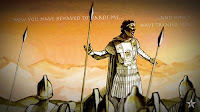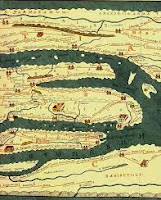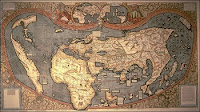This Episode is brought to you by the castle Art because, Castles are awesome and I want to let you know that not only they are awesome but you know that they are some as evidenced by the awesome shirt with an awesome castle on it. Later I will put them in prints…
Greetings, I'm Dawood and in this Article I want to tell you how and why castles were invented? But to begin you have to understand that fortifications existed before castles and the Medieval Period. But why are these fortifications not considered castles and what changed in the time of these earlier fortifications compared to the medieval period that caused the invention of castles. Really great questions and we are going to get into them. It is widely understood in the historical community that the first design of castle that can be rightly called a Castle, it is what is known as the Motte and Bailey.

A Motte-and-Bailey Castle:-
This castle is comprised out of two primary parts and one of them is called the Motte. A Motte is a raised earth work with a fortified structure, a top of it that we would call A keep. The other half is the Bailey now A Bailey simply is an enclosed defensive courtyard and the name is carried on even through the evolution of castles to refer to the inner courtyard of a fully walled off stone castle of a later period that is called a Bailey, Another name for it is also a ward. What’s really interesting when we look at the Motte and Bailey castle is that the two halves are catering specifically to the main functions in which a castle was meant to fulfill matters as someone's residence but also a military fortress. Those two things were quite exclusive before the medieval period and always thanks to the unique conditions of the medieval period giving rise to the need of unifying those two separate things and I'll write more specifically on what those conditions are bit later, what I want to touch on now two different types of fortifications that would join together to give rise to the first type of Castle the modern Bailey because if you were to separate the two halves of a modern Bailey castle you would essentially have two types of fortifications that did exist before and you can actually clearly identify them separate the Bailey from a Motte and Bailey you would have what is called A Ring Fort something that again existed well before the medieval period.
A Ring Fort:-
Now a Ring fort is usually always a fortified farmstead. if you're getting anything bigger than an individual farmstead, you're getting into what would you would generally call a hill fort okay, so these are fortifications before a medieval period before castles a hill fort is generally a fortified community, while a ring fort is generally a fortified farmstead and fortified can probably imply two grand a scale because when we say are fortified in this sense we really are considering it basically it has a basic wall around its perimeter, both for a hill fort and a ring fort now I can get more elaborate on top of this and the wall can be either just a raised earth portion surrounding it or and usually it can have a ditch in front of it and then it can also have a wooden railing on top of the ditch which is called a *palisade.

Castle was designed the way it was I could actually speak a lot more to the design of motte-and-bailey castles and regards to the ditches the Palisades. The separation of the Motte and keep to the Bailey but I'm actually going to make a Article dedicated on the subject because as history tells us this design was superseded there is actually some significant problems that were fixed with later evolution in castle design.
Invention of Castles:-
So the word castle comes from the Latin word Cestrum, which means just a fortified place but technically the word refers to a private fortification owned by King or the lord and not like city walls, so city walls on a castle is just a building, designed for that purpose it would be a place where a king would live it would also be able to defend himself and his family. So the fortifications like this had been around for a really long time starting with you know just piles of earth with wooden palisades on the top of hills of the Roman legions camp they would make every night they would actually build a camp. The castles as we know them as we've seen them along all the roads we've been driving down through the mountains.
Castles were introduced into England shortly before the Norman Conquest in 1066. Before the 12th century castles were as uncommon in Denmark as they had been in England before the Norman Conquest. So that the first style was call it was what's called a Moat and Bailey, So there were you would dig a ditch pile the dirt from that ditch into a hill and then you would build a house on top of it. So it was pretty simple pretty easy to do for a small local ruler near 1,000 on castles began to be built faster and faster. One reason for this is that There was you know that you would do it because you're reacting to some outside pressure like when the Moors Muslims.
(The Moors were a Muslim people of mixed Berber and Arab descent who populated the Maghreb region of northwest Africa during the Middle Ages and the early modern period. Despite originating on the African continent, in the eighth century the Moors conquered the Iberian Peninsula—what we know today as Spain and Portugal).
You get a lot a big boom and castle building because people are waiting to make sure that they're defended from the pirate attacks that would prompt the building of castles. Local rulers would also build them for when they fought each other, so it wasn't necessarily just an outside threat or you could put them up on a river or a road the charge at old . So it's a castle technology evolved that you have them switching from earth to stone. They move towards outside walls with a large keep, a large tower in the inside so to keep is a large building in the center of a lot of castles often times you could actually defend just half the building because there's only connected by one point so if you lost half the building you just keep defending the other half. Often during a siege, there might not actually be normally there might not be platforms along the top of the walls, there just be perhaps holes there where they could build on a platform in the inside of the walls for an actual siege. There'd also sometimes build even wooden things that went out over the wall, so you could drop things down on people below with the Crusades in the 13th century. Castles were maintained over the years by adding on new things new technologies rebuilding them even going into to more modern times the 1800s. A lot of times the castles they've been used by the Romans or at least some type of fort used in Roman times was still used in 1800-1900s even in some places to the present. So each generation would improve one thing that you if you're looking at a castle and trying to figure out is this more of like a palace that a ruler built or upgraded.

Castle's Architecture:-
One thing is whether is it look for Windows if there's windows all along the walls, it's not intended for primarily for defense because that's a good way for people inside to get shot with some missile if there's big windows. So one like this will you see a couple of tiny little windows that's a sign that this was built primarily for defense so artillery, was introduced in the 1320s it really changed castles took a long time to protect them at first they could only fire, you know a few times a day but by 1450s or the main siege weapon and soon they begin to render castles obsolete, because their artillery destroys castles as we know them. A fort that's designed, defend against artillery, looks a lot different, it's a lot lower you're using a lot more earth to absorb the force of the cannonballs.
So about 75,000 to 10,000 castles were built in Western Europe less than 2,000 In England, 14,000 in Germany, So they were a pretty major part of the countryside in a lot of areas.
Castle Architecture remained very popular even after they weren't militarily useful, means poor guy is because you already have all these grand buildings a great place an impressive place to live some of the most famous castles weren't even actually built during the time where they were militarily useful. They were just built to be palaces for a king or a lord and in the 18th and 19th centuries they have Nobles in some areas actually building fake ruins of castles called follies just as a massive lawn ornament just to that add to their elaborate gardens.
Now the history of Castles has come to an end here i am quoting different Sayings about castles to keep the motivation and fascination alive in your minds.
"A Neurotic is a man who builds a castle in the air. A Psychotic is the man who lives in it. A Psychiatrist is the man who collects the rent.", --Jerome Lawrence--
"I'm already used to being a target, so I'm building a castle with the stones people throw at me."--Cris Cyborg--
"Yes, your home is your castle, but it is also your identity and your possibility to be open to others."--David Soul--
“Rocks in my path? I keep them all. With them I shall build my castle.”,-- Nemo Nox--
“Everybody is equally weak on the inside, just that some present their ruins as new castles and become kings –” Simona Panova, Nightmarish Sacrifice.
"There is no castle in the world where fear is not the reason it was built for!”― Mehmet Murat ildan
(“I---" the Beast coughed again. "I hope you like it here." What?
He hoped she liked it here? Like a guest? What an odd thing to say to a prisoner.” ― Liz Braswell, As Old as Time.)
“I am going to build a fortress of books, Will you come inside and live with me?”-― Kamand Kojouri
“No castle can protect you, no castle but the Castle of Reason!”, ― Mehmet Murat ildan
“Every big castle was once started with a single block; despise no small beginnings. A little step taken every day builds up the hope of greater accomplishments. Do something every day!”― Israelmore Ayivor, Daily Drive 365.
“Who needs a castle? Surely not a courageous man! Who needs a guard? Surely not a brave man! Who needs a gun? Surely not a strong man! Cowards need castles, they need guards and guns, simply because they are weak and chicken hearted!” --Mehmet Murat ildan
That's it I hope you have really enjoyed the history and the quotes above , now to keep the fascination alive, you may collaborate them with images as a motivational message as per your choice.
Palisade: A Palisade, sometimes called a stakewall or a paling,is typically a fence or defensive wall made from iron or wooden stakes, or tree trunks, and used as a defensive structure or enclosure. Palisades can form a stockade.
Siege: A military operation in which enemy forces surround a town or building, cutting off essential supplies, with the aim of compelling those inside to surrender.
Medieval Period: In the history of Europe, the Middle Ages or medieval period lasted approx from the 5th to the late 15th centuries. It began with the fall of the Western Roman Empire and transitioned into the Renaissance and the Age of Discovery.
 All for the sake of your lives, your glory and your wealth. And yet here I still am, leading you, as conqueror of land and sea, rivers, mountains and the plains. We’ve celebrated our weddings together. Many of your children will be cousins of my own.
All for the sake of your lives, your glory and your wealth. And yet here I still am, leading you, as conqueror of land and sea, rivers, mountains and the plains. We’ve celebrated our weddings together. Many of your children will be cousins of my own. 






























